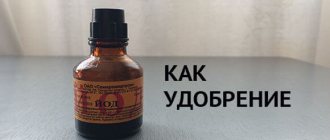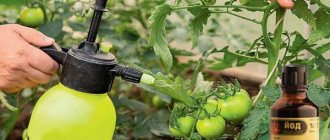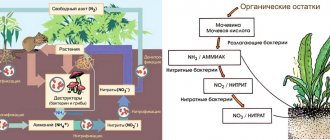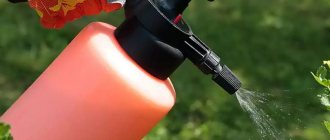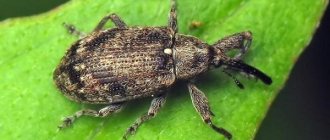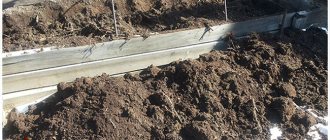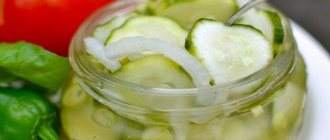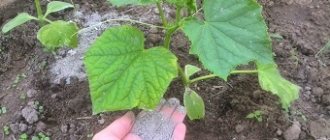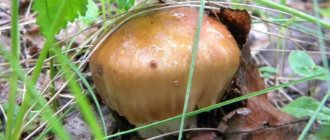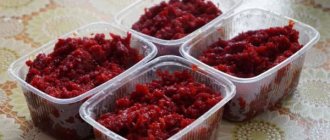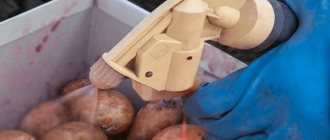Use in the fight against diseases of cucumbers
For root rot:
| Use an aqueous solution Pour a bucket of warm water. Add 2 drops of iodine and 10 drops of brilliant green to it. Mix the liquid well. Water the plants at the root, moistening the lower part of the stems to a height of 15-20 cm. You can use this option as a preventive measure once a month. When fighting rot, water once every 7-10 days. | |
| Add greenery when watering This option improves the immunity of cucumbers. You can use it once a week. Add brilliant green at the rate of 1 drop per 1 liter of water. Water the plants as usual. No special conditions are needed. The main thing is to dose the brilliant green correctly; for this it is most convenient to use a pipette | |
| Lubricate the stem if it is affected by root rot Dilute the solution at the rate of 1 part brilliant green to 2 parts water. The quantity depends on the volume of work, usually you need a little composition. Lubricate the lower part of the stem - from the ground and to a height of 20 cm. Cover the surface generously with a brush or other device. Repeat treatment every 3-4 days until foci of disease disappear |
To combat powdery mildew, downy mildew and late blight:
| Prepare a solution with whey and urea Dissolve 10 ml of brilliant green in 2 liters of whey. Mix well and add 50 g of urea. After this, stir until the granules are completely dissolved. Dilute the finished mixture with a bucket of water. Spray the plants in the evening. Repeat treatment once a week | |
| Use an aqueous solution with milk and iodine Dilute 2 tablespoons of grated soap and 12 drops of iodine in 5 liters of water. Add half a liter of milk and stir the liquid well. Irrigate the cucumbers generously from a watering can. Try to wet the leaves as much as possible | |
| Use milk with iodine or brilliant green Pour 2 liters of low-fat milk into a container. Add 10 ml of iodine or brilliant green to it. Stir until the color is even. Spray plants with a garden sprayer. Do this treatment until powdery mildew disappears | |
| Use an aqueous solution against late blight Add 20 drops of iodine and brilliant green to a bucket of warm water. Stir the liquid. Carry out treatments once every one and a half weeks. Do them until late blight disappears |
What fertilizers are prepared based on whey?
Many nutritional mixtures can be prepared using whey.
Here are the recipes for some of them:
- Recipe No. 1 . 1 liter of yogurt is mixed with 9 liters of water at room temperature. 5-6 drops of iodine are dripped into the solution. Apply several times a month to accelerate crop growth.
- Recipe No. 2 . A 50-liter barrel is filled with mowed grass. A bucket of ash is added to it. Everything is filled with serum. Leave to ferment in a warm place for two to three weeks. To feed the plant, the mixture is diluted with water in equal proportions.
- Recipe No. 3 . Mix 5 tbsp into 2 liters of whey. l. honey, 10 drops of iodine, 1 tbsp. ash. All components are mixed well and infused for two to three days. Used as foliar feeding during the flowering period.
Benefits and harms for cucumbers from using iodine
The benefits that iodine solution can bring to cucumber crops are invaluable in many cases. If you treat plants with it, starting from the earliest stages of their development, then this can replace the use of expensive chemical fertilizers and pesticides.
Iodine, in some cases, will help cure parts of plants already damaged by diseases or pests, but most often (with regular use) it can be used to prevent their appearance and subsequent reproduction.
The benefit of iodine for cucumber seedlings and adult bushes also lies in the fact that it is a microelement that participates in biological processes occurring in plant tissues, as well as in soil nitrogen metabolism. It has the following effect on seeds and cucumbers during the growing season:
- activates seed germination;
- accelerates the growth of bushes, stimulating metabolic processes in their tissues;
- stimulates flowering and fruit set;
- increases the duration of the growing season (plants wither much later) and, accordingly, fruiting.
The effect of iodine solution as a preventive, therapeutic (in the early stages of fungal diseases) agent on plants can be compared with copper-containing fungicides used for this purpose. An even greater antiseptic effect from its use can be obtained by mixing iodine with brilliant green - both drugs increase the effect of each other and become even more effective.
There are only two disadvantages of using iodine solutions on cucumbers:
- Toxicity of vapors when used indoors (in a greenhouse);
- Possibility of chemical burns to plants due to an overdose of iodine in the working fluid.
What are the advantages of the solution
It’s very simple to prepare the solution, even if the proportions are not exactly met, nothing bad will happen.
Let’s look at the advantages of treatment with iodine and whey:
- Availability of all components . Buying whey and iodine is not difficult; they are sold in all localities and are inexpensive. And those who keep cows have no problems with whey at all.
- Simplicity and safety of preparation . Even a child can prepare the solution. The proportions are easy to maintain and even if they are slightly off, nothing bad will happen. The composition does not contain toxic or hazardous components, so you can prepare the mixture and use it without the use of protective equipment.
- Environmental friendliness of the composition . By treating plants with whey and iodine, you do not increase the amount of nitrates in the soil. Plants do not accumulate any harmful substances and you get an environmentally friendly harvest.
The serum has a number of beneficial characteristics, which are further enhanced by the addition of iodine.
- High content of minerals, proteins and vitamins . The mixture is very nutritious and has a good effect on the development and growth of cucumbers, stimulating their development. The soil is enriched and the structure becomes lighter; with constant use, the general condition of the soil improves.
- The ripening time is reduced and the taste of the fruit is improved . The plant as a whole bears fruit much better, fruit set improves and the fruiting period increases.
- Lactic acid bacteria serve as an excellent disease prevention and means of combating them . They have an inhibitory effect on pathogenic microorganisms and destroy them both on the plant and in the soil.
- Versatility of use . The solution is equally good for cucumbers and tomatoes, as well as many other vegetable crops. You can use it without any special restrictions, because it contains no harmful components.
The use of fertilizing with whey and iodine significantly prolongs the fruiting period and thereby increases productivity.
The author of the video explains a preventative option using only whey or low-fat milk. A mixture is prepared at the rate of 2 cups of dairy product per liter of water. Plants are sprayed once a week for preventive purposes.
Rules for processing plants
After treatments, a thin film is formed on the foliage of plants, which protects the plants from harmful bacteria. Spraying with milkshakes is effective, but the protection does not last long. Therefore, experienced summer residents try to use them more often - about once every 10 days.
The list of vegetables that require such spraying includes:
- tomatoes;
- cucumbers;
- squash;
- zucchini.
Regular treatments protect tomatoes from fusarium and late blight, and cucumbers from insidious powdery mildew.
With fermented milk product you can make fertilizers for root and foliar feeding. Each method has its advantages, but mainly spraying (foliar methods) is used for tomatoes and cucumbers. In this case, nutrients are not washed out of the soil, and the effect of exposure occurs earlier.
In the first period of the growing season, it is advisable to alternate methods of applying fertilizers, but in the second, switch only to root ones. Spraying is allowed only to combat infections.
Failure to comply with the dosage of the product and the application of serum irregularly often leads to disruption of the acid balance of the soil, and this can also negatively affect the root system of plants.
Therefore, for this fertilizer and for all others, it is necessary to strictly adhere to the amount of components in solutions.
It is especially important to prevent imbalance of the microclimate in greenhouses, since at high temperatures a large amount of acidic compounds will be released there. To do this, be sure to ventilate the greenhouses and control the humidity level in them.
To do this, be sure to ventilate the greenhouses and control the humidity level in them.
Reviews from gardeners
Olga, Kharkov
Iodine + milk (whey) is for viral diseases. Downy mildew is a completely different story - a fungal disease, which requires fungicides.
Source: forum.vinograd.info
Alla, Moscow
If you mix 40 drops of iodine with a liter of whey and a tablespoon of hydrogen peroxide in 10 liters of water, you will get an excellent remedy for combating the hated late blight. By adding a liter of low-fat milk and 10-12 drops of iodine to 9 liters of water, you get a solution that destroys downy mildew on cucumbers.
Source: www.forumhouse.ru
Spraying cucumbers with milk with iodine and boric acid
Experienced summer residents know how to process cucumbers to set the ovary and improve fruiting. In stores you can buy many factory-made drugs that affect the growth and development of crops. However, their disadvantage is that they often contain chemical components. Proponents of a healthy diet prefer the use of folk and safe remedies, which include pharmaceutical boric acid, iodine, milk, and whey.
Spraying cucumbers with milk with iodine has long been used as a preventative against fungal infection of the plant. Treatment of cucumber bushes with this mixture is used in the following cases:
- as a top dressing;
- for the prevention of damage to cucumbers by powdery mildew, late blight, and gray rot;
- to prevent yellowing and falling leaves.
Preference should be given to homemade milk or whey. They create a dense protective layer on the surface of the leaf that protects the bush from diseases and pests. Iodine is a good tool for feeding and disinfecting cucumbers from infections.
How to prepare a solution for spraying cucumbers with milk and iodine? For this you will need:
- Liter of whey or milk. They must be fresh and preferably homemade.
- 30-50 drops of iodine.
- Laundry or liquid soap. If bar soap is used, then rub it on a fine grater. You will need about 30 grams. Then you need to wait for it to dissolve. Liquid soap is easier to use. 3-5 doses of soap per bucket of water are enough.
All components are dissolved in 10 liters of warm water. Start spraying cucumbers in the evening, when the sun disappears below the horizon. Experienced summer residents use the biological product “Fitosporin” as an additional component to increase the effect of treatment. In this case, the result after processing will become even more obvious.
Spraying cucumbers with milk with iodine has long been used as a preventative against fungal infection of the plant.
The use of boron as foliar feeding of cucumbers has a positive effect on crop yield. 1-2 grams of the drug is enough to spray the plant to get good results. According to reviews, after processing the vegetables become stronger and larger, and have good shelf life.
It is recommended to use boron at the stage of pre-sowing seed preparation. To do this, planting material is soaked in a solution of boric acid. To prepare it you will need 1 gram of boric acid per 1 liter of water. The seeds are left in the solution overnight.
For foliar feeding you will need at least 5 grams of boric acid. To ensure that the drug dissolves well, a concentrated solution is first prepared. You will need hot water into which 5 grams of boric acid is poured. It is stirred until completely dissolved and poured into 10 liters of water. This treatment is recommended to be carried out monthly. The first spraying is carried out before the start of flowering of cucumbers, the second - during the fruiting period.
Why spray cucumbers with whey?
Whey is obtained from the fermentation of milk during the production of cottage cheese, cheeses, and casein. The main part of its composition is water, and only 5% of microelements necessary for the growth and development of the crop.
This:
- calcium;
- potassium;
- phosphorus;
- magnesium;
- nitrogen.
It also contains amino acids, vitamins and lactic acid bacteria.
What does this product give to the plant:
- the root system is actively developing;
- high growth of green mass;
- active formation of the ovary;
- lactic acid bacteria, together with the alkaline level of the culture, create a protective field against diseases and pests;
- lactic bacteria suppress pathogenic microflora.
Did you know? If you treat cucumbers with a whey solution during flowering, you can reduce the number of barren flowers.
Recipes and rules of use
Since the antiseptic is volatile, safety precautions should be observed when working with products that contain a chemical compound. Recipes for the use of a medicinal product in the agricultural field are different, which is associated with the purpose of the product. The chemical element is added to fertilizers, protective solutions, and concentrates for pre-sowing seed treatment. If the dosages are observed, vegetables grown with iodized treatments are stronger, more tasty, and the fruiting phase increases noticeably - by 10-14 days.
Top dressing
Iodine is effective as a fertilizer: it acts as an antiseptic while speeding up metabolism. This stimulates a greater number of ovaries, longer periods of flowering and fruiting. Fertilizing by watering cucumbers with iodine, according to numerous reviews from vegetable growers, improves their taste. It allows vitamin C to concentrate in greens. The recipe for preparing root dressing, which demonstrates the best effect, is simple: dilute 1 drop of the product in 3 liters of warm water. The resulting solution should be fertilized and watered every 2 weeks.
For your information! Thanks to double treatment with iodine, subject to other rules of agricultural cultivation (watering, soil treatment), the yield can be increased by 30-40%.
Disease Prevention
If you regularly spray cucumber plantings with iodine solution, it will increase the protective functions of the plant and prevent the development of diseases. The first treatment can be carried out 3 months after planting the seedlings or after the formation of the third true leaf (for direct sowing). The interval is a week. If the bushes need to be watered, do it the day after spraying. Sequence of preparation steps:
- Mix 1 liter of milk and 30 drops of medication in one container.
- Pour the resulting mixture into a bucket of water.
- Add 15 ml of liquid soap as an adhesive.
- Spray the bushes with a spray bottle.
Seed treatment
To obtain healthy greens over a long period, it is necessary to strengthen the immunity of plants and stimulate their development at the stage of pre-sowing treatment. Pre-soaking the seeds in an iodine mixture of the drug with water improves germination, accelerates germination, and hatched seedlings begin to grow much faster, forming strong stems.
For seedlings
The chemical element is also needed by seedlings. The main thing is to follow the dosage, preparing solutions with the required concentration. The use of the product will improve the tolerance of fledgling vegetable plantings not only to pathogenic organisms, but also to unfavorable weather conditions (cold snaps, sharp fluctuations in daily temperatures, lack of sun due to more cloudy days).
It is better to water the seedlings with iodine solution. It is prepared from 3 liters of water and 1 drop of antiseptic. Root feeding is carried out 1 or 2 times during the period of seedling development. Since the green mass of the seedlings is very tender, it is better to avoid spraying on the leaves. Contact with even the smallest concentration of the product can lead to severe burns.
Treatment
Vegetable plants, if cultivation practices are violated, as well as in beds in rainy, cold summers or closed ground, are susceptible to fungal diseases: powdery mildew, gray rot, late blight. No less dangerous are the attacks of melon aphids, which cause significant damage to the crop - the shortage can be more than 30%. Protective treatments with an antiseptic help cure cucumbers and get rid of colonies of dangerous insects.
Recipes for iodine solutions for common harmful organisms
For your information! To avoid the use of pesticides when treating gray rot in greenhouses, use iodine (20 drops) together with urea (50 g) three times a season. The basis of the solution is whey (2 l) and warm water (10 l).
What is useful and how to prepare the solution
Whey contains a large number of useful substances, it contains a lot of lactose, proteins, mineral elements, amino acids and vitamins. They play a big role in the growth and development of garden crops. Without them, plants will be weak and sick, and their fruits will be tasteless. The serum also helps fight various types of pests. She:
- destroys fungi that like to grow on plant leaves;
- helps stop the increase in pathogens.
Lactic bacteria contained in whey accelerate the appearance of humus and the decay of organic residues of other plants. Both the soil and the bushes are enriched with the product, that is, foliar treatment is carried out.
Benefits of watering cucumbers with whey:
- a large number of useful substances;
- ease of preparation;
- availability in stores;
- disease prevention;
- treatment of diseases in the early stages;
- suitable for growth;
- indulgence in pest control;
- can be used for seedlings;
- environmentally friendly product.
Disadvantages of treating cucumbers with whey:
- easy to wash off;
- at large doses it harms plants;
- spoils quickly;
- harms crops in a spoiled form;
- may cause allergies in people with lactose intolerance.
To ensure maximum nutrient content, there are a number of rules when making such fertilizer. You need to take natural milk, which has not yet been boiled or pasteurized; it contains the maximum concentration of nutrients and microorganisms. Keep the milk at a temperature of 20-25°C until it becomes sour. Pass the already acidic product through a filter (ordinary gauze will do).
It is important to know!
Excessively long exposure leads to the appearance of pathogenic fungi, which have a detrimental effect on the health of plants.
Use the resulting liquid to feed cucumbers in the garden, but not in its pure form:
- To replenish the soil, you need to dissolve it with water in a proportion of 100 ml. product per 1 liter. water. The water temperature should be 20-25°C. The resulting solution is used to cultivate the soil at a distance of 50 cm from the plant.
- To treat the bushes themselves, it is advisable to increase the concentration. Prepare the solution in a proportion of 330 ml. for 1 liter of water.
- To make the solution stick to the bushes, you can add a little laundry soap, crushed in advance.
If stored for more than 48 hours, the solution begins to ferment and can subsequently harm the crops. Cucumbers need to be watered according to the rules.
Precautionary measures
The main thing when using whey is not to overdo it with the drink. Otherwise, the acid balance of the soil will be disrupted, which will affect the health of the plants. Using undiluted product may burn roots and leaves.
Attention! Whey is not harmful to humans, but people with dairy allergies need to be careful.
Even the simplest methods have specific application. Recommendations from gardeners:
- Use warm (23-24 degrees) and settled water for the solution;
- the whey must be fresh, without heat treatment;
- follow the recipe exactly;
- Apply the solution on the day of preparation. Otherwise, pathogens may appear in it.
The milk fermentation product does not harm the plant, so it can be used at any stage of development. It is also not dangerous for beneficial insects.
Preparation of the solution
Using serum, you can prepare various products that can protect cucumbers from diseases and saturate the soil with useful microelements. The drink will also help improve flowering.
With water
Heat-loving cucumbers may turn yellow if the temperature drops sharply. In this case, a solution will help, which can be prepared according to the recipe:
- kefir (yogurt) – 2 liters;
- water - bucket;
Mix the components thoroughly before spraying.
Attention! The serum in its pure form can only be used when powdery mildew or late blight occurs.
But even in these cases, it is sprayed on damaged areas of the plant with caution. For preventive treatment against diseases, you can prepare a solution of 1 liter of liquid and 2 glasses of fermented milk product
Spray leaves every 7 days
For preventive treatment against diseases, you can prepare a solution of 1 liter of liquid and 2 glasses of fermented milk product. Spray the leaves every 7 days.
With iodine
Spraying cucumbers with iodine serum is a common procedure used by vegetable growers. There is nothing strange in this, since these substances increase the effectiveness of the product, complementing each other
But in order for the culture not to suffer, it is important to maintain proportions. Using such a solution, you can cure plants from diseases and accelerate the ripening of fruits
To prepare it you need:
- serum – 1000 ml;
- water – 1 bucket;
- iodine – 5 drops.
Mix all the ingredients and spray the vegetables with it twice a month. A positive result will be noticeable as soon as the first treatment of cucumbers with whey and iodine is carried out: the color of the leaves will become saturated, the plants will develop faster and the fruits will ripen ahead of schedule. This product is suitable for greenhouse crops and those growing in open ground.
With grass
An infusion of whey with nettle or other type of herb is an effective fertilizer. To prepare it, you need to mix:
- water – 7 liters;
- whey - 3 liters;
- grass - 1/3 of a 10-liter bucket.
Close the container for two weeks to allow the ingredients to ferment. Use the resulting mixture as a root feeding, after diluting 1000 ml of solution in 10 liters of water.
With ash
Vegetable growers use another fertilizer recipe based on whey and ash, which is very effective. The ash contains a lot of phosphorus and potassium, which the crop needs at the stages of bud emergence and ovary formation. To prepare the solution you need:
- water – 10 liters;
- ash – 2 tbsp;
- iodine – 10 drops;
- whey – 2 liters.
Attention! Use settled water for fertilizer.
Mix the ingredients and leave for 48-72 hours. Apply fertilizer at the root or use it to spray the tops.
Action of the solution
The serum used to process cucumbers and tomatoes is an excellent prevention of the formation of pathogenic fungal diseases; the components it contains actively suppress fungi and bacteria, without causing any harm to the plants themselves. The serum can be used to feed young plants as well as adults.
To saturate varieties of parthenocarpic cucumbers, as well as ordinary ones, with beneficial amino acids, whey with iodine is ideal. This is also an excellent prevention against late blight. As you know, this disease is quite insidious. If the weather is damp and cloudy, then late blight will definitely affect your garden. Preventive measures should be carried out immediately after planting seedlings. But is it possible to feed cucumbers with urea, and how to do it correctly, is indicated here.
In the video - serum and iodine for cucumbers and tomatoes:
And if it is necessary to protect plants from pests, then iodine comes to the rescue. Due to their specific smell, all parasites leave the garden. Iodine also needs to be used to increase metabolism in plants and stimulate growth. If you use it in combination with eversion, you can effectively and quickly defeat fungal diseases. But how to feed cucumbers after planting in a greenhouse, and what products should be used, is indicated here.
Recipes for combined fertilizers
Feeding tomatoes with iodine involves the use of other components that are also necessary for plants. The main substance interacts well with other ingredients, thereby enhancing the healing effect of each.
Milk with iodine
Much has been said about the benefits of iodine. What are the benefits of milk? Scientists have proven that pests and pathogenic microorganisms do not tolerate lactose and milk sugar. You need to use natural milk (not store-bought).
Thanks to milk-iodine solutions, fungi are destroyed, fruits have a beautiful appearance, and growth is accelerated. Dairy products contain a huge amount of amino acids, microelements, phosphorus, potassium, which improves plant photosynthesis.
There are several effective recipes that you can use:
- Mix 10 liters of water with 1 liter of raw milk and 10 drops of iodine. Spray the bushes with 0.5 liters of solution per bush. You can use it 3-4 times per season, since the mixture is not very concentrated.
- Solution without water. For 1 liter of cow's milk you will need 15 drops of iodine. Mix thoroughly and spray the bushes at the rate of 1 cup of mixture per seedling. Frequency of use – no more than 3 times per season.
Boric acid and iodine
Boron is a necessary substance for tomatoes during ovary formation and flowering. Useful properties for tomatoes:
- formation of the root system;
- increase in the number of buds;
- strengthening the immune system;
- increase in sugar content;
- acceleration of the maturation process;
- tops development;
- improving the absorption of other beneficial substances.
Boric acid does not have the properties of accumulation in the soil and tissues of bushes. For this reason, overdose is excluded.
Recipes for boron-iodine supplements:
- Gently heat 10 liters of water, add 12 g of boric acid, add 5 drops of iodine. Use for foliar feeding (per 1 sq. m - 1-1.5 liters of solution).
- For 5 drops of boron, take 3 drops of iodine, 200 ml of fresh milk, 3 liters of water. Apply 500 ml of solution under each bush three times per season.
Serum with iodine
Fermented milk products contain bacteria of the same name, which inhibit the development of pathogenic microorganisms. When sprayed, the serum gets onto the tops and fruits, after which it forms a protective film. Additionally, the plant is saturated with microelements, which accelerates growth and improves the taste of the fruit.
Recipes:
- For root feeding, use a solution of 1 liter of whey, 15 drops of iodine, 4 liters of warm water. Add 0.5-1 liters under the bushes 2-3 times per season.
For foliar fertilizer, combine 2 liters of water with a glass of whey and 3 drops of iodine. Spray using the standard method.
Iodine with greenery
Brilliant greens are considered an antiseptic drug with a high content of copper and other beneficial substances. It has the same effect on tomatoes as iodine. It is prohibited to overuse the mixed solution, as the plant will get burned.
Recipes:
- Mixture for root application of fertilizer: a bucket of water, 20 drops of iodine, 40 drops of brilliant green. Water 0.5 liters per bush.
- For spraying: per 10 liters of water – 10 and 20 drops (iodine/diamond green). For 1 sq. m need 1.5 liters of solution.
- If plants are affected by fungal diseases, make a concentrated solution: 1 tsp of iodine, 2 tsp. greenery and water. Wet the stem in the root area (maximum 10 cm from the surface of the ground). Carry out the procedure 3 times every week.
How to make plant serum
In order for the lactic acid product to retain the maximum beneficial properties for tomatoes and cucumbers, you need to adhere to certain rules in preparation. They differ somewhat from standard processing of milk for food consumption.
The product is prepared only from natural milk, which has not been boiled or pasteurized. This allows you to preserve bacteria of the genus Pseudomonas, which are very beneficial for the soil and are included in some EM preparations. For the same reason, the product is not subjected to long-term heat treatment.
How to cook:
- raw milk is kept at room temperature until it sours;
- the sour product is filtered through gauze;
- The drained liquid is used to feed plants.
Prolonged exposure of sour milk can lead to severe souring of the product . As a result, mold fungi and flora harmful to plants are formed in the whey, and it acquires a musty and bitter odor. A properly prepared product has a pleasant fermented milk aroma.
Processing rules
The serum is easy to use, but there are still certain rules. If you adhere to them, a positive result is guaranteed.
- Use fermented milk product for the prevention of cucumbers no more than three times per season.
- The interval between use should be at least 1-1.5 weeks.
- To prepare the mixture, the milk fermentation product must be diluted with warm water.
- Watering is carried out not at the root, but at a distance of 0.5 meters from the crop.
It is necessary to process one leaf at a time in open ground in the morning, in the evening and in cloudy weather. And spraying a plant in a greenhouse must be accompanied by good ventilation so that condensation does not form in a closed structure. Otherwise, the development of powdery mildew and rot cannot be avoided.
Spraying of foliage can be carried out on both sides. It is also necessary to cultivate the soil around the plant.
How to treat cucumbers with whey
Fertilizing cucumbers in open ground should begin 10 days after planting. Root and foliar application of fertilizer should be alternated every 7-14 days.
To water 1 bush of a crop, 1 liter of solution is needed. After fertilizing, you need to water the plant with clean water to wash the product off the leaves. You need to spray the stems and leaves every 10 days. If the vegetables are strong, then carry out the procedure once every 30 days. Treatment of young seedlings with serum can be carried out weekly. The last time you need to feed with fermented milk drink is a few weeks before harvest.
Processing in open ground
Serum for processing cucumbers is an excellent remedy against diseases and parasites. It is better to use it in the evening or in the morning, before intense heat appears. If you do not follow this rule, you can burn the foliage.
Attention!
Do not fertilize the crop during strong winds or precipitation.
If it rains after the procedure, you should repeat it. In addition, spraying the crop after precipitation will help protect the plant from late blight.
Treatment of cucumber diseases with iodine and brilliant green
Fungal diseases of cucumbers affect yield reduction. They not only affect individual areas of the vegetable crop, but can also contribute to the death of the plant or the entire bed. Zelenka and iodine act as inexpensive, accessible folk remedies in the fight against diseases of cucumbers.
Basal and root rot
Cucumbers can develop diseases such as basal and root rot. As it develops, the foliage begins to fade.
After planting the seedlings, you can notice that the roots have turned brown, the lower foliage has begun to turn yellow, and the ovaries are beginning to die.
Root rot affects the stem near the root
For the purpose of preventive measures, young bushes must be watered at the root every week with the following solution: add 0.5 teaspoons of brilliant green to 10 liters of water. You can also use iodine instead of brilliant green.
Treatment of vegetable crops is carried out a little differently. The ingredients should be taken in a 1:2 ratio. For 1 teaspoon of brilliant green/iodine, take 2 teaspoons of water. The resulting liquid must be treated with a brush on the damaged area of the stem. This action is recommended to be carried out several times a week. Usually, two procedures are enough to get rid of the fungus.
Another method is to lubricate the affected cucumber stem with brilliant green, and then spray with an iodine-containing solution.
Powdery mildew
Its signs include the appearance of yellow spots on the leaves. Over time, they cover an increasingly larger area, which leads to the death of the seedling. To combat the disease, there are the following recipes:
- Dilute 3 drops of iodine in one liter of water and add 1000 ml of milk. The resulting liquid should be sprayed weekly on all damaged areas;
- Stir 0.5 teaspoons of brilliant green in one liter of water and add ammonia (1 teaspoon). Spraying is carried out similarly to the first method;
- 40 drops of iodine must be mixed in a bucket of water, adding 2 g of potassium permanganate and 2 g of boric acid. This solution also helps fight root rot.
Leaves of cucumbers affected by powdery mildew
Downy mildew
The disease is considered dangerous. During flowering or fruiting, the foliage acquires yellow spots on top and gray-violet spots on the bottom. Without taking measures, the turgor of the leaves begins to lose elasticity and dies.
The following solution can help overcome the disease: 1 ml of brilliant green must be diluted in one liter of water, then add 25 g of urea and half a liter of whey to it. The resulting mixture should be sprayed on the plant three times: during the formation of ovaries, before and after flowering.
Beneficial properties of fermented milk product
Whey is obtained from whole milk by separating it from the curd. This yellowish liquid consists of 93-94% water and only 6-7% dry matter. The product is not only cheap, but also absolutely safe for cucumber bushes.
The beneficial properties of whey for vegetable crops are endless. Most often it is used in combination with iodine. This solution successfully fights many diseases. But you just need to use the fermented milk product wisely, given that it has high acidity.
As a fertilizer
The whey contains valuable amino acids and microelements such as phosphorus, zinc, nitrogen, calcium, iron, potassium and sulfur. Cucumbers are a heat-loving plant, and with any changes in the environment, their leaves turn yellow, dry out and fall off. The whole bush suffers.
What is the use of serum when processing cucumber bushes:
- prevents the development of rotting;
- stimulates the development of ovaries and growth;
- saturates the plant with amino acids and microelements.
Expert opinion
Stanislav Pavlovich
Gardener with 17 years of experience and our expert
Ask a Question
Reference! The fermented milk product works as an organic fertilizer. Thanks to it, the bushes will be strong and strong.
In pest control
Using a dairy product in its pure form is ineffective, so solutions are prepared on its basis with the addition of iodine, boric acid, ash or various herbs, the smell of which helps repel insects.
Using the serum, which caterpillars, moths and other pests love so much, a trap is prepared. Fermented milk liquid is poured into a pan or jar to a third of its volume and placed overnight in an area where there is an abundance of harmful insects.
In the fight against disease
Fermented milk product has an acidic environment, due to which there is an active fight against pathogenic microorganisms. The acidic environment is aimed at inhibiting fungi and bacteria. Therefore, the serum is used to treat cucumbers for the following diseases:
- late blight;
- root rot;
- powdery mildew.
These diseases are the main enemies of vegetable crops. After treatment, the bushes recover, and the damage disappears without a trace. The serum can be applied at the root to the soil or sprayed on the foliage.
Expert opinion
Stanislav Pavlovich
Gardener with 17 years of experience and our expert
Ask a Question
Often the effect of the product is enhanced by the addition of iodine. This solution creates a protective protein film on each leaf; it prevents spores of pathogenic fungi from germinating in the plant tissue.
Insect protection
Insects are attracted to whey, so vegetable growers use it for traps. They fill a small container 1/3 with undiluted drink and leave it on the beds for the whole night. In the morning, the pests are taken out and destroyed. Fermented milk product helps destroy:
- aphids;
- onion fly;
- caterpillar;
- codling moth.
But the effect of the serum is short-lived, so it will not get rid of large colonies of insects. But it is possible to cope with a small number of pests. To do this, dilute 1 liter of milk fermentation product and 50 g of grated laundry soap in 5 liters of water.
Pour the vegetable mixture generously. Repeat the procedure 2-3 times every 1-1.5 weeks.
Whey for cucumbers
The first spraying of cucumbers with serum is carried out in early July. In mid-summer, the greatest likelihood of developing fungal diseases occurs. A thin film of the medicinal composition will protect the cucumber leaves from powdery mildew, and if the fungus has already begun to develop, it will destroy it. It is better to remove leaves with traces of powdery mildew and burn them.
Spraying cucumbers with milk and iodine gives good results. The concentration of nutrients in milk is much greater, but the percentage of fat in it should be small. As a result of treatment with an excessively fatty composition, a too dense film is formed on the leaves, impeding the access of oxygen and nutrients.
How to water and spray
As it became known, serum with iodine can be used both for spraying and watering cucumbers and tomatoes. If you decide to treat the plant against pests, then you need to use a special tool - a sprayer. But you can read here when to spray gooseberries against powdery mildew with topaz.
By using such a solution, the appearance of parasites on the leaves can be prevented. After applying the solution, a thin film forms on the plant. This is achieved due to the fact that the serum contains acidic bacteria. Thus, reliable protection of cucumbers from fungi is created.
The solution is also used for root treatment. But it is worth noting that it is not durable. So it is necessary to water cucumbers regularly. Only frequent watering, judging by reviews of Herman cucumbers, will create reliable protection against pests and at the same time saturate the plants with useful components. It is best to water in the month of July. It is at this time that cucumbers need reliable protection from the attack of parasitic fungi, and also require minerals. But what to do when the tips of cucumber leaves turn yellow, and what fertilizers and fertilizers should be used, you can find out by clicking on this link.
Why is iodine used in gardens?
There are quite a few cases when you can use iodine solution on cucumber plantings in open ground or in greenhouses. For example, in the following cases:
- used to fight infections;
- used as fertilizer along with other components;
- used to prevent the occurrence of diseases and pests;
- The seeds are treated and iodine is used for better germination.
It turns out that this simple antiseptic can be used literally at all stages of plant development and in all main cases of its agricultural technology. In addition, it is always available, costs a penny, which allows you to save on more expensive preventive and protective agrochemicals, and is also completely environmentally friendly, which means that the fruits collected from the bushes after spraying can be eaten immediately, simply by washing them with clean water.
Features of processing in greenhouses and open ground
Features of processing cucumbers in greenhouses and open beds have some distinctive features:
- In open beds there is a high probability of rain, so it is important that no rain falls on the cucumbers in the first couple of hours after spraying. During this time, the solution will have time to be absorbed into the sheet and create a protective film on it that will last for the next 5-7 days.
- In closed structures, precipitation is excluded, but air circulation is not so intense. Therefore, you need to use treatment less often. It is carried out approximately once every 14 days.
- For preventive purposes, the solution is recommended to be used to disinfect the surface of a greenhouse or greenhouse. In open beds you can cultivate the soil. So that microbes do not develop in it.
Advice! If bottles with iodine without lids are placed in the greenhouse, late blight will not appear on the plantings.
